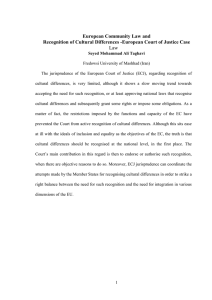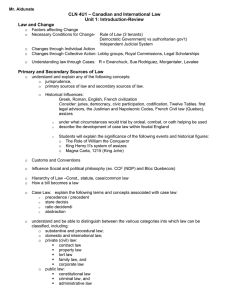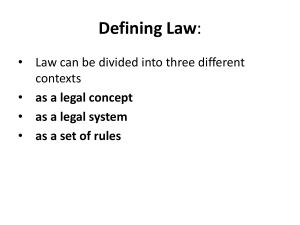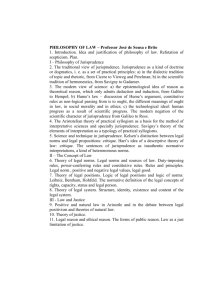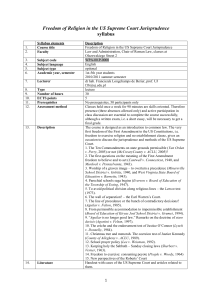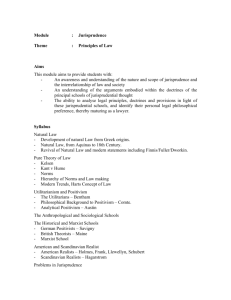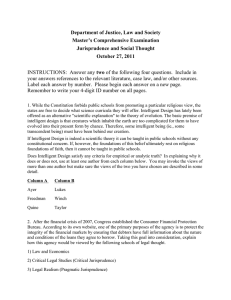Book Reviews When History Mattered
advertisement
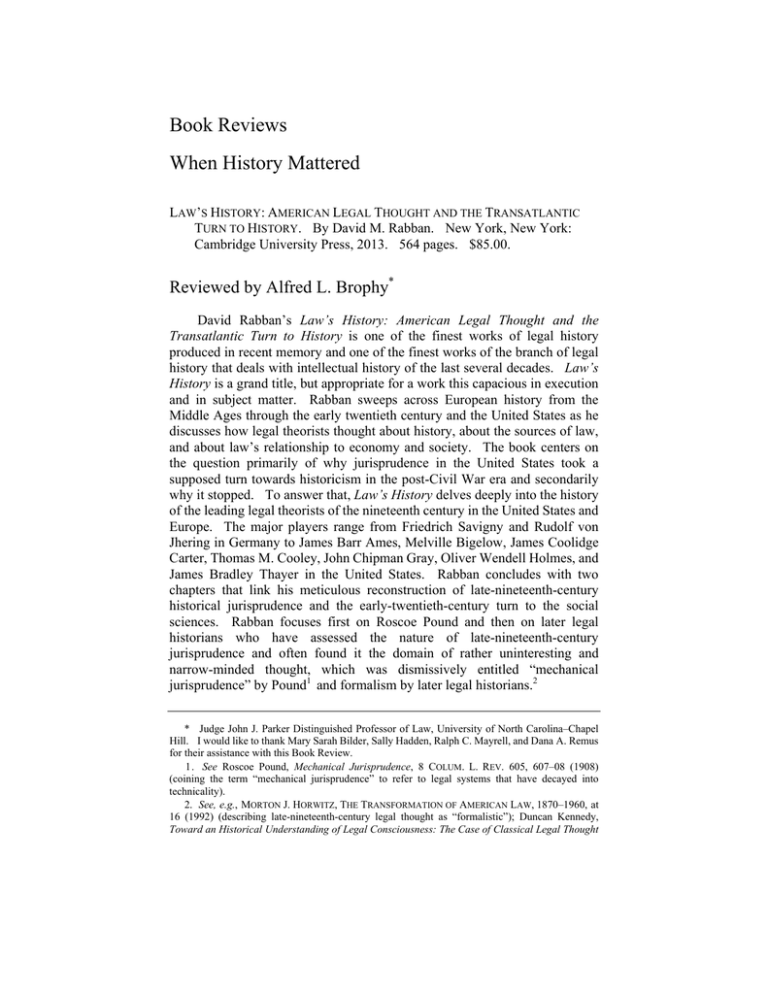
Book Reviews When History Mattered LAW’S HISTORY: AMERICAN LEGAL THOUGHT AND THE TRANSATLANTIC TURN TO HISTORY. By David M. Rabban. New York, New York: Cambridge University Press, 2013. 564 pages. $85.00. Reviewed by Alfred L. Brophy* David Rabban’s Law’s History: American Legal Thought and the Transatlantic Turn to History is one of the finest works of legal history produced in recent memory and one of the finest works of the branch of legal history that deals with intellectual history of the last several decades. Law’s History is a grand title, but appropriate for a work this capacious in execution and in subject matter. Rabban sweeps across European history from the Middle Ages through the early twentieth century and the United States as he discusses how legal theorists thought about history, about the sources of law, and about law’s relationship to economy and society. The book centers on the question primarily of why jurisprudence in the United States took a supposed turn towards historicism in the post-Civil War era and secondarily why it stopped. To answer that, Law’s History delves deeply into the history of the leading legal theorists of the nineteenth century in the United States and Europe. The major players range from Friedrich Savigny and Rudolf von Jhering in Germany to James Barr Ames, Melville Bigelow, James Coolidge Carter, Thomas M. Cooley, John Chipman Gray, Oliver Wendell Holmes, and James Bradley Thayer in the United States. Rabban concludes with two chapters that link his meticulous reconstruction of late-nineteenth-century historical jurisprudence and the early-twentieth-century turn to the social sciences. Rabban focuses first on Roscoe Pound and then on later legal historians who have assessed the nature of late-nineteenth-century jurisprudence and often found it the domain of rather uninteresting and narrow-minded thought, which was dismissively entitled “mechanical jurisprudence” by Pound1 and formalism by later legal historians.2 * Judge John J. Parker Distinguished Professor of Law, University of North Carolina–Chapel Hill. I would like to thank Mary Sarah Bilder, Sally Hadden, Ralph C. Mayrell, and Dana A. Remus for their assistance with this Book Review. 1. See Roscoe Pound, Mechanical Jurisprudence, 8 COLUM. L. REV. 605, 607–08 (1908) (coining the term “mechanical jurisprudence” to refer to legal systems that have decayed into technicality). 2. See, e.g., MORTON J. HORWITZ, THE TRANSFORMATION OF AMERICAN LAW, 1870–1960, at 16 (1992) (describing late-nineteenth-century legal thought as “formalistic”); Duncan Kennedy, Toward an Historical Understanding of Legal Consciousness: The Case of Classical Legal Thought 602 Texas Law Review [Vol. 91:601 Rabban is engaged in a deep reconstruction of ideas. Part of the mission is to show that late-nineteenth-century historical writers understood that legal doctrine and statutes were embedded in their social and economic context and evolved in reaction to surrounding changes. Relatedly, he critiques those who portray that jurisprudence as static, backwards, and disconnected from society. Perhaps he also hopes to re-establish for legal history a larger place in early-twenty-first-century jurisprudence. On that first mission, Rabban builds on some other very good work in late-nineteenth-century jurisprudence.3 On the second, his findings correlate with some others about the nature of late-nineteenth-century jurisprudence, which see the labeling of Gilded Age jurisprudence as formalist as incorrect.4 There is much to say about Rabban’s methods, his findings, and his argument that we should think rather differently about Gilded Age legal thought and the transition to the Progressive Era than we have as we have followed the writings of Roscoe Pound. Given the extraordinary number of themes running through this book and the attention it has already received, 5 I want to focus on three issues of particular interest to me. First, what accounts for the shift to historicism in American jurisprudence? In mapping the rise in historical jurisprudence there are issues in dating the shift and in explaining how and why it occurred. That is partly a methodological question about how change in legal thought occurs. I think that the shift began before the Civil War and was driven at least partly by the arguments for and against slavery. My second area of interest is the nature of historical jurisprudence itself. How did historical jurisprudence see the relationship between law and its surrounding culture? Between legal thought and legal doctrine? Rabban shows that the historical jurisprudence was quite varied, but presumably it is helpful in understanding in America, 1850–1940, 3 RES. L. & SOC. 3, 5 (1980) (rejecting the classification of late-nineteenth-century legal thought as “formalism,” and instead preferring the term “Classical legal thought” to describe the period). 3. See generally KUNAL M. PARKER, COMMON LAW, HISTORY, AND DEMOCRACY IN AMERICA, 1790–1900 (2011) (tracing the historical development of modernist legal thought in the late nineteenth century); Stephen A. Siegel, Historism in Late-Nineteenth Century Constitutional Thought, 1990 WIS. L. REV. 1431 [hereinafter Siegel, Historism] (exploring the relation of historism and laissez-faire constitutionalism in late-nineteenth-century constitutional thought); Stephen A. Siegel, Joel Bishop’s Orthodoxy, 13 L. & HIST. REV. 215 (1995) (discussing the legal thought of Joel Bishop and his contribution to late-nineteenth-century jurisprudence); Stephen A. Siegel, John Chipman Gray and the Moral Basis of Classical Legal Thought, 86 IOWA L. REV. 1513 (2001) (discussing the writings of the late-nineteenth-century legal scholar John Chipman Gray and the moral basis of Classical legal thought); Lewis A. Grossman, James Coolidge Carter and Mugwump Jurisprudence, 20 L. & HIST. REV. 577 (2002) (discussing the jurisprudence of the late-nineteenth-century legal scholar James Coolidge Carter and the Mugwumps). 4. See BRIAN Z. TAMANAHA, BEYOND THE FORMALIST–REALIST DIVIDE: THE ROLE OF POLITICS IN JUDGING ch. 4 (2010) (discussing commonly held beliefs about legal formalism). 5. See generally Ron Harris, The Politics of Historical Narratives: Comment on David Rabban’s Law’s History, 1 JERUSALEM REV. LEGAL STUD. 81 (2010) (commenting on Rabban’s Law’s History); Roy Kreitner, Heroes, Anti-Heroes, and Villains, 1 JERUSALEM REV. LEGAL STUD. 96 (2010) (same). 2013] When History Mattered 603 Gilded Age jurisprudence. While this historical jurisprudence varied in its understanding of the process of evolution and in the role that historical analysis played in understanding law, I believe that a central tendency of it was towards a jurisprudence of individualism and freedom of contract. My third area of interest is the transition from historical to sociological jurisprudence around the turn of the twentieth century. Rabban finds more points of connection between those two periods than we are used to hearing, and I wonder how much Rabban is successful in portraying continuity among those schools. I. The Turn to History in American Jurisprudence David Rabban locates the turn to history in American jurisprudence in the years following the American Civil War, in what is commonly thought of as the beginning point of American jurisprudence. 6 This was the era when Oliver Wendell Holmes was doing his work, when Christopher Columbus Langdell was teaching and writing, and when the great treatise writers like Thomas M. Cooley and James Coolidge Carter were preparing their work.7 The typical story is that before the War, Americans were hopeless romantics (or fanatics), many of whom embraced the stifling and heartless labor system of slavery. It was the War that brought the massive and modern state with its huge changes in manufacturing, transportation, finance, technology, and constitutional and statutory law. That is, the War is often thought of—correctly—as a transformative and watershed moment in American thought.8 Rabban sees the postwar era as the time that historical thought came to American jurisprudence, and he ties this to a trend in Western thought towards history. Rabban depicts this process happening in two stages. First, German scholarship of the early nineteenth century, led by Savigny, turned to history to understand law. Savigny, like Edmund Burke, was responding to the excesses of the French Revolution and the Enlightenment theories of natural law that seemed not to work so well in practice.9 That turn to history in Germany in the early eighteenth century worked its way to Great Britain, where people like Henry Maine applied it in Ancient Law, and then to the United States after the War, through people who studied in Germany in the postwar period.10 Thus, Rabban’s story is one of elite intellectual culture—of the transmission of 6. See, e.g., NEIL DUXBURY, PATTERNS OF AMERICAN JURISPRUDENCE 2 (1995) (locating the start of American jurisprudence at approximately 1870). 7. DAVID M. RABBAN, LAW’S HISTORY: AMERICAN LEGAL THOUGHT AND THE TRANSATLANTIC TURN TO HISTORY 1, 15 (2013). 8. WILLIAM E. NELSON, THE ROOTS OF AMERICAN BUREAUCRACY, 1830–1900, at 157 (1982) (identifying the Civil War as “the great watershed in the nineteenth century”). 9. RABBAN, supra note 7, at 5, 70–71, 73–74, 78. 10. Id. at 4–5. 604 Texas Law Review [Vol. 91:601 ideas from university settings in Europe to university settings in the United States.11 I suggest that the turn to historical thought in American jurisprudence occurred before the Civil War. Recall that the turn to historicism was well underway by the early nineteenth century—Savigny’s major work appeared in the 1810s12 and Henry Maine’s Ancient Law was published in 1861.13 So the historical school of jurisprudence was certainly well-established in Europe before the Civil War. The turn to historicism resulted at least partly from the debate over slavery because of the utility of arguments based on history made by people engaged in a very practical debate. What is the evidence that the historical school was established in the United States before the Civil War? One of the key pieces of evidence of historical thought in the pre-Civil War United States is Thomas R. Dew’s 1852 A Digest of the Laws, Customs, Manners, and Institutions of the Ancient and Modern Nations, which was delivered first as lectures at William and Mary.14 This was in essence a legal history of western civilization, stretching from ancient Egypt, Greece, and Rome through the French Revolution. A central theme is the role of property rights in leading to freedom in northern European countries.15 Dew was an influential historian, whose 1832 booklet criticized the proposal of gradual abolition of slavery in Virginia in the wake of Nat Turner’s rebellion by demonstrating the economic impracticality of abolition. 16 Dew turned to history, as had many conservatives in the wake of the French Revolution, to show that radical reform would likely lead to disastrous results.17 History was not just something that was an intellectual fad; it was a science of truth. History was, as Thomas Carlyle said, “[p]hilosophy teaching by [e]xperience.”18 Or so conservatives thought. 11. Id. 12. FRIEDRICH CARL VON SAVIGNY, VOM BERUF UNSERER ZEIT FÜR GESETZGEBUNG UND RECHTSWISSENSCHAFT [THE VOCATION OF OUR AGE FOR LEGISLATION AND JURISPRUDENCE] (1814). 13. HENRY SUMNER MAINE, ANCIENT LAW: ITS CONNECTIONS WITH THE EARLY HISTORY OF SOCIETY, AND ITS RELATION TO MODERN IDEAS (John Murray 1920) (1861). 14. THOMAS DEW, A DIGEST OF THE LAWS, CUSTOMS, MANNERS, AND INSTITUTIONS OF THE ANCIENT AND MODERN NATIONS (1852). Herbert Hovenkamp traces some of the other roots of pre-Civil War evolutionary thought in Herbert Hovenkamp, Evolutionary Models in Jurisprudence, 64 TEXAS L. REV. 645 (1985). 15. See Alfred L. Brophy, The Intersection of Property and Slavery in Southern Legal Thought: From Missouri Compromise Through Civil War (May 17, 2001) (unpublished Ph.D. dissertation, Harvard University) (on file with the Bell & Howell Information and Learning Co.). 16. Id. at 158–60. 17. See THOMAS R. DEW, REVIEW OF THE DEBATE IN THE VIRGINIA LEGISLATURE OF 1831 AND 1832, at 58–59 (1832) (arguing that the expulsions in European countries of people from different races had catastrophic effects on the economy and society). 18. Thomas Carlyle, Parliamentary History of the French Revolution, in 4 CRITICAL AND MISCELLANEOUS ESSAYS 163, 164 (1860). 2013] When History Mattered 605 The same year that Dew’s Laws, Customs, and Manners came out, Little Brown—who would publish Holmes’s The Common Law in 188119—brought out a book with a very similar title, The Theory of the Common Law.20 It was substantially more doctrinal than Holmes; it was history designed to teach what happened, rather than—as Holmes used history—as a shovel to clean up what had been left by the receding tide of history. Six years later Thomas R.R. Cobb, a law professor at the Lumpkin Law School in Athens, Georgia, published an extended treatise on slave law that began with nearly two hundred pages of An Historical Sketch of Negro Slavery.21 Cobb argued that slavery was nearly ubiquitous in human history and that recent emancipation in the West Indies and the Caribbean led to economic disaster 22 (for white people). He used this to argue that the common and international law preferred slavery to freedom. 23 This was applied history—a study of history that taught important proslavery lessons. And that was persuasive; it was cited in the southern courts more than twenty-five times from its publication through the end of the Civil War. In fact, it continued to be cited after the war. In an extraordinary twist of fate, Oliver Wendell Holmes cited Cobb’s treatise in one of his final opinions while on the Massachusetts Supreme Judicial Court.24 The case dealt with a claim by the child of a formerly enslaved man who had been born while the man was a slave in Virginia. The decedent had been married during his time as a slave. 25 Afterward he escaped to Massachusetts and remarried. 26 The question was whether the first child—born during the era of slavery—was the only legitimate heir.27 Holmes distinguished Cobb’s conclusion that slaves brought from a free state to a slave state continued as slaves (and thus could not marry), but concluded that certainly slaves who remained in Massachusetts were free and thus the second marriage was legitimate.28 19. O.W. HOLMES, JR., THE COMMON LAW (1881). 20. JAMES M. WALKER, THE THEORY OF THE COMMON LAW (1852). 21. 1 THOMAS R.R. COBB, AN INQUIRY INTO THE LAW OF NEGRO SLAVERY IN THE UNITED STATES OF AMERICA (1858). 22. Id. at cxcvi–cxcvii, 10. 23. Id. at cxcvii–cc, 50–51. 24. Irving v. Ford, 60 N.E. 491, 492–93 (Mass. 1901). 25. Id. at 492. 26. Id. 27. Id. at 493. 28. Id. at 492–93. Another prominent twentieth-century use came in In re Campbell’s Estate, 108 P. 669, 673 (Cal. Dist. Ct. App. 1910) (citing United States v. Roach, 92 U.S. 27 (1875) (citing COBB, supra note 21)) (determining that slaves could not contract during the era of slavery). The California court went on to deny the right of children of such a marriage to inherit from their parents, because such children were illegitimate. Id. at 676. This is one example of post-Civil War reasoning, which effectively extended the disabilities of slavery for decades after slavery ended. Such reasoning, focusing on the nature of contract, looked narrowly at legal doctrine without looking at its social context or its likely consequences. 606 Texas Law Review [Vol. 91:601 Reformers in the antebellum era like Ralph Waldo Emerson often argued that we should not believe the past,29 while those who turned to history often did so for conservative motives.30 This was part of the Romantic era’s focus on context rather than grand Enlightenment-era universal truths.31 The turn to context and the sense that the amount of freedom people are entitled to varies according to their status were responses to the notion born of the Revolutionary era that all people are created equal. In fact, as American jurisprudes turned towards history, they argued that people are not all entitled to or fit for freedom. That was a powerful argument restraining the move towards emancipation.32 A key part of Rabban’s picture of historical jurisprudence is its acknowledgment of change. He uses Henry Maine’s book Ancient Law as evidence that historical jurisprudence had a sense of evolution, from status to contract.33 That sense of evolution was a key part of both pre- and post-Civil War American thought. The American progression was at one point cyclical (drawing on evidence of decline of classical republics); this is illustrated by Thomas Cole’s series of five landscape paintings, Course of Empire. They depicted the same spot over eons, as the empire rose from the savage state to pastoral, consummation, destruction, and finally desolation. Yet, Americans in the 1840s and 1850s saw their trajectory as one of only upward progress. Justice Levi Woodbury commented about Cole’s Course of Empire in discussing Americans’ shift from a cyclical progression to a line pointing ever upward in an address entitled (of course) “Progress” at Dartmouth College in 1844.34 Woodbury depicted progress by individuals and society, and thought it was modern society where “liberty and law, the arts and the securities of 29. See Ralph Waldo Emerson, Literary Ethics, in RALPH WALDO EMERSON: ESSAYS & LEC101 (Joel Porte ed., 1983) (“The perpetual admonition of nature to us, is, ‘The world is new, untried. Do not believe the past. I give you the universe a virgin today.’”). 30. DANIEL D. BARNARD, MAN AND THE STATE: SOCIAL AND POLITICAL: AN ADDRESS DELIVERED BEFORE THE CONNECTICUT ALPHA OF THE PHI BETA KAPPA 6 (1846) (“This is, with us, the age of reform, or, rather, of reformers, and if we do not look to it, there is some danger that we may, by and by, find our people reformed out of all just notions, and every sound principle, in social affairs, in matters of government, and in religion.”). 31. See, e.g., ALBERT TAYLOR BLEDSOE, AN ESSAY ON LIBERTY AND SLAVERY 274–83 (1856) (arguing that the “experiment” of freedom in St. Domingo led to revolt and a decline in industry, indicating that some people were not suited for freedom). 32. See, e.g., James P. Holcombe, Is Slavery Consistent with Natural Law?, 27 S. LIT. MESSENGER 401, 408 (1858) (arguing that for certain inferior races, slavery prevents the enslaved from descending into “hopeless degradation” and is thus given both “the sanction of justice” and “the lustre of mercy”). 33. RABBAN, supra note 7, at 70. 34. Levi Woodbury, On Progress, Address Before the Phi Beta Kappa Society of Dartmouth College (1844), in 3 WRITINGS OF LEVI WOODBURY, LL.D. POLITICAL, JUDICIAL AND LITERARY 75 (1852). TURES 93, 2013] When History Mattered 607 organized government, reign.”35 Woodbury embraced, as did Maine, a distinct preference for modern society over ancient.36 There were other pre-war origins of postwar thought—especially the turn towards empiricism as a way of countering historical arguments. Empirical arguments were used occasionally before the War by proslavery writers, for instance, to argue that slavery was better than freedom for the enslaved.37 But much more frequently antislavery thinkers used empiricism to argue that slavery and slave law were inhumane. One of the best-known antislavery works of the 1850s was William Goodell’s The American Slave Code in Theory and Practice.38 It drew upon accounts in legal reporters and other sources discussing trials involving slaves to detail the inhumanity of the slave code and the way slavery operated.39 This turn to empiricism was a direct challenge to the historical arguments advanced by proslavery writers. And the most famous of all antislavery works, Harriet Beecher Stowe’s Uncle Tom’s Cabin, 40 provides perhaps an important link to Oliver Wendell Holmes’s later thinking. There is an uncanny parallel between Uncle Tom’s Cabin and Holmes’s imagery in Southern Pacific Company v. Jensen41 that law was the command of the sovereign, not a “brooding omnipresence in the sky.”42 For at the beginning of the novel Stowe proclaimed that “over and above” the scene of the forced sale of slaves when their owners went into bankruptcy there “broods a portentous shadow—the shadow of law.”43 One wonders whether when Holmes saw law as the command of the sovereign, rather than ubiquitous custom, he had Stowe’s compelling imagery in mind. That is, American jurisprudence was both historical and empirical—or one might say sociological44—before the Civil War, though it was after the 35. Id. at 78. 36. See id. This evolutionary picture of law that moves to a more sophisticated, commercial republic based on contract correlated with the era of freedom of contract and of individualism. 37. See GEORGE FITZHUGH, CANNIBALS ALL! OR SLAVES WITHOUT MASTERS 18 (C. Vann Woodward ed., Belknap Press of Harvard University 1988) (1857) (concluding, through observational evidence, that young, elderly, and female slaves “have all the comforts and necessaries of life provided for them” while the Northern “free laborer must work or starve”). 38. WILLIAM GOODELL, THE AMERICAN SLAVE CODE IN THEORY AND PRACTICE (1853). 39. See, e.g., id. at 154–59 (detailing the account of a slave-owner who was acquitted of battery after shooting a slave following a minor offense, because, inter alia, the slave “must be made sensible that there is no appeal from his master”). 40. 1 HARRIET BEECHER STOWE, UNCLE TOM’S CABIN; OR, LIFE AMONG THE LOWLY (1852). 41. 244 U.S. 205 (1917). 42. Id. at 222. 43. STOWE, supra note 40, at 24 (“So long as the law considers all these human beings, with beating hearts and living affections, only as so many things belonging to the master,—so long as the failure, or misfortune, or imprudence, or death of the kindest owner, may cause them any day to exchange a life of kind protection and indulgence for one of hopeless misery and toil,—so long it is impossible to make anything beautiful or desirable in the best regulated administration of slavery.”). 44. For one might recall that the term sociology was employed by a pre-Civil War southerner writing about slavery. See GEORGE FITZHUGH, SOCIOLOGY FOR THE SOUTH, OR, THE FAILURE OF FREE SOCIETY v (1854) (“New exigencies in [society’s] situation had given rise to new ideas, and to a new philosophy. This new philosophy must have a name, and as none could be found ready-made to 608 Texas Law Review [Vol. 91:601 war that many of these elements appeared in greater amplitude. Thus, I see a different timing of the shift to historicism and also a different cause of that shift. Rabban sees the primary cause as a high-brow, intellectual movement. There may, of course, be rather distinct historical turns in American jurisprudence: the turn that Rabban describes may have been made separately (though to essentially the same place) and for different reasons from the one I describe. II. The Nature of Historical Jurisprudence: The Age of Freedom of Contract However and whenever historical jurisprudence came to the United States, there are important questions of its meaning, its breadth, and its central tendencies. Rabban argues that historical jurisprudence was not all about political conservatism based on a static vision of law;45 that its adherents had a wide spectrum of ideas; 46 and that their ideas were not just doctrinal and internal, but widely focused on law’s relationship to society and on how law responded to the social stimuli around it.47 He succeeds in showing that historical jurisprudence dealt with all sorts of issues, some deeply conservative, others apolitical, and yet others more flexible and engaged with reform. And he shows that it was not narrowly focused on development of doctrine, but was attuned to custom and thus to surrounding culture.48 Some of the historical jurisprudence was nationalistic, such as the “Teutonic germ theory,” teaching that Anglo–American ideas of freedom—even the New England town meeting—emerged from the German forests.49 Some of it was antiquarian; some taught the importance of stopping change through the power suit the occasion, the term Sociology was compounded . . . as the technical appellative of the new-born science.”). 45. See RABBAN, supra note 7, at 71 (“In specific political views, as well as in general ideological orientations, the evolutionary historical thought of leading nineteenth-century scholars correlated with both conservative and liberal positions.”). 46. Id. 47. Id. at 327–31 (noting that “[w]hile applying evolutionary thought to legal analysis, American legal scholars frequently emphasized that evolving custom is the source of law,” and using historical scholarly opinions to show how “American legal scholars typically associated legal history with national history”). 48. Id. 49. Id. at 69, 72 (citing RICHARD HOFSTADTER, SOCIAL DARWINISM IN AMERICAN THOUGHT 147 (1970); PETER NOVICK, THAT NOBLE DREAM: THE “OBJECTIVITY QUESTION” AND THE AMERICAN HISTORICAL PROFESSION 87 (1988)); id. at 89 (citing Herbert B. Adams, New Methods of Study in History, in 2 JOHNS HOPKINS UNIVERSITY STUDIES IN HISTORICAL AND POLITICAL SCIENCE 25, 101 (Herbert B. Adams ed., 1884)). 2013] When History Mattered 609 of judicial review.50 Holmes’s legal historical scholarship, by contrast, made change possible by showing the artifacts left by a receding time of history.51 Rabban thus identifies a diversity of ideas among adherents of historical jurisprudence, and he has looked far deeper at that scholarship than anyone before him. That diversity of political ideologies of its adherents should not obscure two things. First, often the historical work’s ideological orientation had little connection to present issues and the scholarship was ignored by courts. 52 Second, the central tendency of Gilded Age jurisprudence was towards classical liberalism and towards a sense of progress that moved, if anything, from collective to individual. One of Rabban’s points about the diversity of ideas—and an important rebuttal to the cardboard image of Gilded Age jurisprudence—is that historical jurisprudence demonstrated that law gradually evolved over generations.53 The sense of evolution correlates with the shift that was taking place from a local economy to a transnational commercial law. Yet, the realization that law evolved gradually was consistent with conservative thinking. For instance, Christopher Tiedeman’s Law and the Unwritten Constitution celebrated the conservative and liberty-loving aspects of Anglo–Americans that showed little tolerance for change.54 Later Tiedeman attacked legislation as the product of socialism and communism and portrayed the unwritten constitution, which was based on the community’s sense of history, as the defense against democracy. 55 Tiedeman recognized that there might be 50. For instance, Christopher Tiedeman’s analysis in The Unwritten Constitution of the United States, of changes in the contracts clause, which Rabban reads as endorsing an evolutionary model of constitutional change, might also be read as saying that the evolution in constitutional law that permits the police power to restrict the protection the contracts clause provided to corporations is troublesome. See C.G. TIEDEMAN, THE UNWRITTEN CONSTITUTION OF THE UNITED STATES 54–57 (William S. Hein & Co., Inc. reprint ed. 1974) (1890); RABBAN, supra note 7, at 322–24. 51. RABBAN, supra note 7, at 238–40 (detailing Holmes’s evolutionary theory of law, which traced primitive conceptions to current common law, and noted that sometimes precedents survive “long after the use they once served is at an end and the reason for them has been forgotten”). 52. For those whose political message was at best hidden, the role of history in the pre-Civil War treatises was often substantially more attuned to the relationship between law and its surrounding culture than much of the postwar historical school that Rabban examines. One might, for instance, contrast Henry Cabot Lodge’s essay with Dew, who sought to understand how the whole system fit together. Compare H. Cabot Lodge, The Anglo-Saxon Land-Law, in ESSAYS IN ANGLO-SAXON LAW 55, 56–57 (1876) (discussing the growth and sometimes decay of “certain strong conceptions” upon which Anglo-Saxon property law is based), with Dew, supra note 17, at 103 (describing various nonlegal factors, including “the rise of the towns, the springing up of a middle class, and a change of agriculture,” to explain the gradual emancipation of slaves in western Europe). Lodge was concerned with narrow and internal questions about the doctrinal development in Anglo-Saxon land law. Lodge, supra, at 56–57. 53. See RABBAN, supra note 7, at 325–27 (describing historical jurisprudence’s application of “evolutionary thought to legal analysis”). 54. TIEDEMAN, supra note 50, at 20 (“It is not so much what is found in the written constitution, as the conservative, law-abiding, and yet liberty-loving character of the Anglo-Saxon, which guarantees a permanent free government to England and to the United States of America.”). 55. Id. at 80–82. 610 Texas Law Review [Vol. 91:601 changes but argued that history provided a stabilizing force amidst the change, and he was thankful for it. The central tendency of the age of historical jurisprudence was towards conservative principles. Where legal history today so frequently serves to destabilize, because it shows alternative legal ideas or past inequities,56 legal history in the Gilded Age sometimes—though not always, as Holmes demonstrates57—served to justify the present, to show that there was a reason for the often slow and almost imperceptible progression, 58 or to suggest modest reforms.59 Jurisprudence in this era also taught that the natural order of things was towards respect for property rights and classical liberalism. This was the era of contract, as Henry Maine told us in Ancient Law.60 Thomas Cooley, James Coolidge Carter, and Christopher Tiedeman confirmed it.61 One demonstration of this “age of freedom of contract” is the fact that the number of state court opinions in which the terms “freedom” and “contract” appeared within two words of each other increased in the decade of the 1890s.62 Courts were influenced by—and adopted principles of—freedom of contract. The work of many historical jurisprudence scholars supported classical liberalism. Without stepping into the difficult questions of causation between legal literature and judicial outcomes, I note that judges were going in the direction of classical liberalism as well. To see the power of the appeal of classical liberalism in the Gilded Age, one might turn to State 56. See, e.g., William W. Fisher III, Texts and Contexts: The Application to American Legal History of the Methodologies of Intellectual History, 49 STAN. L. REV. 1065, 1103 (1997) (“[T]he objective of . . . legal historians in particular should be to destabilize rather than reinforce Americans’ nationalism and exceptionalism.”). 57. RABBAN, supra note 7, at ch. 7. 58. JAMES C. CARTER, THE IDEAL AND THE ACTUAL IN THE LAW 26 (1890) (“[T]here is a gradual, insensible and unconscious progress in the law. We do not perceive the movement, but it becomes apparent by comparing its condition at different and widely separated periods of time. It is thus that the Common Law starting from rude beginnings has expanded itself into the vast and consistent scheme which affords a safe bulwark for all the great classes of rights.”). 59. See, e.g., id. at 25–26 (arguing that while “the sole office of the judicial tribunals [is] to find existing customs,” judges, who chiefly deal with “doubtful cases,” can make slight improvements to the law by preferring “good customs to bad ones”). 60. See MAINE, supra note 13, at 319 (“[T]he society of our day is mainly distinguished from that of preceding generations by the largeness of the sphere which is occupied in it by Contract.”). 61. See CLYDE E. JACOBS, LAW WRITERS AND THE COURTS: THE INFLUENCE OF THOMAS M. COOLEY, CHRISTOPHER G. TIEDEMAN, AND JOHN F. DILLON UPON AMERICAN CONSTITUTIONAL LAW v–vi (2001) (concluding that “the works of Cooley and Tiedeman were instrumental in the formulation, development, and application of the liberty of contract principle as a limitation upon the police power of the states and the commerce power of the national government”); id. at 27–32 (discussing the importance of Cooley’s treatise in the development of liberty of contract); id. at 58–63 (describing the importance of Tiedeman’s work to the incorporation of laissez faire principles, including liberty of contract, as constitutional limitations on legislative power); HORWITZ, supra note 2, at 118–21 (describing Carter’s leadership of the New York Bar’s opposition to proposed codification of the common law). 62. The word “freedom” appears within two words of “contract” in the Westlaw allstates-old database 6 times from 1880 to 1889 and 39 times from 1890 to 1899. 2013] When History Mattered 611 v. Fire Creek Coal & Coke Co.,63 which Roscoe Pound used as evidence of the focus on freedom of contract over community rights.64 It held that a statute that prohibited mining companies from charging their employees more for goods than the companies charged nonemployees was an “unjust interference with the rights, privileges, and property of both the employer and the employee, and places upon both the badge of slavery, by denying to the one the right of managing his own private business, and assuming that the other has so little capacity and manhood as to be unable to protect himself, or manage his own private affairs.”65 III. The Turn from History to Sociology My final question relates to the turn that Rabban makes in the final two chapters to assess what happened when American jurisprudence moved out of its historical mode towards sociological and realist jurisprudence. One of Rabban’s key points is that the changes from the historical school to the sociological school were not nearly so stark as those in the sociological school (or subsequent historians) have suggested.66 Rabban suggests that the change was not so great as it has been portrayed, because the historical school was already engaging with issues of how law developed in conjunction with society.67 American jurisprudence was already empirical.68 Related to this, Rabban argues that the sociological school that came after created a false image of a static jurisprudence before it.69 Much of Rabban’s connection of historical jurisprudence and sociological jurisprudence turns on his depiction of historical jurisprudence as empirical and evolutionary. But part of the distinction turns on the central tendencies of sociological jurisprudence. Here I would focus on Pound’s critique of court cases that set up classical liberalism and restricted government regulation.70 Moreover, Pound saw important distinctions between historical jurisprudence and sociological jurisprudence. One of the things that strikes me about Pound is how much he drew rigid lines between 63. 10 S.E. 288 (W.Va. 1889). 64. Roscoe Pound, Do We Need a Philosophy of Law?, 5 COLUM. L. REV. 339, 353 (1905) (quoting Fire Creek Coal, 10 S.E. 288). 65. Fire Creek Coal, 10 S.E. at 289. 66. RABBAN, supra note 7, at 512. 67. See RABBAN, supra note 7, at 430–31 (noting that legal historians recognized societal influences on the law). 68. See id. at 430 (“[The historical school] opposed deductive formalism while emphasizing their commitment to history as an inductive science . . . .”). 69. Id. at 512. 70. See, e.g., Roscoe Pound, Law in Books and Law in Action, 44 AM. L. REV. 12, 32–33 (1910) (discussing Puritan ideas of individualism); Roscoe Pound, The Need of a Sociological Jurisprudence, 19 GREEN BAG 607, 612 (1907) [hereinafter Pound, Sociological Jurisprudence] (“Legal monks who pass their lives in an atmosphere of pure law, from which every worldly and human element is excluded, cannot shape practical principles to be applied to a restless world of flesh and blood.”). 612 Texas Law Review [Vol. 91:601 the philosophical, analytical, and historical schools.71 Those lines did not exist in practice; they probably could not. Analytical jurisprudence draws on empirical evidence, for instance, to understand the values to plug into utilitarian calculations. This is partly an issue of the distance from the subject. Looked at closely, as Rabban does, there are shades of gray, midway points between the individualism of the Gilded Age and the world of the sociological jurisprudence of the early twentieth century.72 All of this is part of the recent trends in the academy to see gradations, rather than the sharp distinctions that the actors themselves, such as Roscoe Pound, saw. Yet, as with the turn to history, I believe that the turn away was due to a lot more than the work of legal thinkers such as Roscoe Pound. It was time for a jurisprudence of economics and sociology that looked to classes, government regulation, and protection of the workers. I think this is an important change in emphasis from the era of freedom of contract, individualism, and historicism73 to the era of economics and sociology. The shift may have been to legitimize statutory law that moved in keeping with the political, economic, and social reality of the early twentieth century. The lessons, if any, about Teutonic germ theory, about the glacial adaption of the common law, and about the need for protections of corporations against the police power, were out of keeping with the early twentieth century. There was a sense by Pound and others that courts should abandon doctrines like freedom of contract.74 Pound argued for the need to look at effect on the community—not just individuals but the entire community.75 That led scholars like Pound 76 to create what we might think of as the “Lochner image in the progressive legal mind.” Lochner was, perhaps, more a creation of the Progressive-era scholars who sought to overturn it than it was 71. Roscoe Pound, The Scope and Purpose of Sociological Jurisprudence, 24 HARV. L. REV. 591, 591–92 (1911) (discussing analytical, historical, and philosophical schools of jurisprudence). 72. See, e.g., TAMANAHA, supra note 4, at 40–43 (arguing that the rapid social change that occurred between the 1870s and the 1930s led older, individualist-oriented judges to gradually move the common law in a more progressive, socially oriented direction); Siegel, Historism, supra note 3, at 1540–46 (advancing the position that the evolution of late-nineteenth-century legal thought is more fully understood as a process whereby modern historicism replaced historicism rather than as an abrupt change from one set of beliefs to another set of beliefs). 73. There are virtually no cases cited in the book up to the last two chapters. In the last two chapters, Rabban shifts attention to how jurisprudence engaged with the surrounding world and with cases. This shift in data sources may account for some of the changing picture of jurisprudence. 74. See, e.g., Pound, Sociological Jurisprudence, supra note 70, at 607–08 (discussing the pervasive public sense that the law as it was did not guarantee a just outcome, and placing blame for this development squarely with the way law is discussed and taught). 75. Id. at 612–13. 76. See, e.g., Jetsam and Flotsam: Law in Books and Law in Action, 69 CENT. L.J. 362, 362 (1909) (quoting a speech given by Pound at the Maryland State Bar Association in which he cited Lochner v. New York, 198 U.S. 45 (1905) as an example of an opinion in which “courts in practice tend to overturn all legislation which they deem unwise”). 2013] When History Mattered 613 representative of the age.77 Or so one might think. Sociological jurisprudence advocates wanted something very different from the central tendency of the era—they wanted calculations based on the impact of rules on the general public, rather than based on individual claims between two competing parties. They wanted courts and legislatures to make calculations based on their determination of the public good rather than classical liberalism. In the hands of sociological jurisprudence, “[l]aw is no longer . . . mysterious.”78 Law had lost its majesty; it was not a brooding omnipresence in the sky, but was subject to remaking by the legislature. Conclusion We have only begun to understand Rabban’s reconstruction of the world of the late nineteenth century and its implications for legal thought in that time and in the decades following it. There are issues of methodology and interpretation that will take years to work through. For instance, the individualism of the late nineteenth century may be a product of the free labor ideology of the pre-Civil War Republican party. 79 How those ideas relate to the legal historical scholarship of people like Thayer, Ames, and the others Rabban talks about remains unclear. Moreover, one wonders if Rabban’s meticulous reconstruction of the ideas of the historical school of jurisprudence has insight into the late-twentieth-century debate about the extent to which legal theory is concerned with politics, for it may tell us something about law’s connections to politics in the nineteenth century.80 Rabban has opened a world that we did not know existed and invited us to see how it relates to the world before, during, and afterwards in the academy and the judiciary. Law’s History comes amidst a resurgence in legal history, because it is increasingly seen as a method, much as law and economics is a method.81 If that resurgence continues it will be because legal history scholarship continues to tell us something relevant about contemporary law, such as how legal doctrine and practice respond to changes in culture and what the context of a 77. Horwitz makes a similar point about the Progressive-era critique of Lochner, but sees the Lochner era as suspicious of corporations. See HORWITZ, supra note 2, at 7 (asserting that the Lochner Court viewed large corporations as “unnatural and illegitimate”). 78. Pound, Sociological Jurisprudence, supra note 70, at 610. 79. Among the many places one might find these ideas are the writings of Republican economic and political thinkers. See generally, e.g., ERIC FONER, FREE SOIL, FREE LABOR, FREE MEN: THE IDEOLOGY OF THE REPUBLICAN PARTY BEFORE THE CIVIL WAR (1995) (discussing the melding of values and interests into early Republican ideology); HEATHER COX RICHARDSON, THE GREATEST NATION OF THE EARTH: REPUBLICAN ECONOMIC POLICIES DURING THE CIVIL WAR (1997) (arguing that wartime Republican economic policies were not “haphazard” responses to the exigencies of war, but rather part of a broader vision aimed at transforming the nation’s economy in the long term). 80. See, e.g., HORWITZ, supra note 2, at 193 (“The most important legacy of Realism therefore was its challenge to the orthodox claim that legal thought was separate and autonomous from moral and political discourse.”). 81. See Alfred L. Brophy, Multivariate Analysis Through Narrative History, 15 GREEN BAG 2D 465, 469 (2012) (asking whether legal history is a method like law and economics). 614 Texas Law Review [Vol. 91:601 statute’s history tell us about its application. In this, legal history has, as David Rabban shows, a long tradition behind it. And maybe we will see that history in conjunction with economics and sociology has a great deal to teach us about the development of legal institutions even now.
